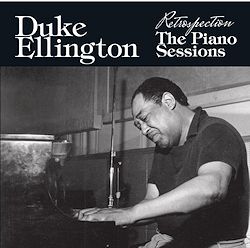1. Who Knows
2. Retrospection
3. B Sharp Blues
4. Passion Flower
5. Dancers In Love
6. Reflections In D
7. Melancholia
8. Prelude To A Kiss
9. In A Sentimental Mood
10. Things Ain’t What They Used To Be
11. All Too Soon
12. Janet
13. Kinda Dukish
14. Montevideo
15. December Blue
16. All The Things You Are (Version 1)
17. All The Things You Are (Version 2)
18. Piano Improvisation No.1
19. Piano Improvisation No. 2
20. Piano Improvisation No.3
21. Piano Improvisation No.4
22. New World A-Comin’
23. Variations On Mood Indigo
Duke Ellington – Piano
Wendell Marshall – Bass (tracks 1-15)
Butch Ballard – Drums (tracks 1-12)
Dave Black – Drums (tracks 13-15)
Jimmy Woode – Bass (tracks 16-21)
Sam Woodyard – Drums (tracks 16-21)
In his biography of Duke Ellington, the author Scott Yanow writes the following: “In the history of American music, Duke Ellington stands alone.” Ellington
was a prodigious composer, bandleader (which lasted until his death) and pianist. However, for the most part, since Ellington generally thought of the
orchestra as his instrument, only infrequently did he venture to play piano in a trio, duo or solo setting. This release from Phoenix Records entitled Retrospection: The Piano Sessions gives us an opportunity to hear The Duke in that context and to appreciate what a great pianist he was.
Duke Ellington grew up in a middle-class family in Washington DC listening to music. He took some basic piano lessons starting at age five but was, for the
most part self-taught, picking up part of his style early on from the Washington stride piano players. By age seventeen he was playing regularly on a
professional basis for dances and parties. In 1923, Ellington moved to New York but established himself in Harlem and by 1924 he was leading his own band
around which he built his musical identity.
As he led the orchestra from his piano bench, Ellington the pianist sometimes did little more than set the tempo, fill in with chords, and cue the
soloists. He was, of course, much more than that as these tracks attest. Tracks 1 to 12 were originally released on Capitol Records in 1953 as The Duke Plays Ellington, with tracks 13 to 15 added for the 1989 CD release entitled Piano Reflections. Tracks 16 to 21 were part of a
release for Columbia Records in 1961 called Piano In The Foreground.
It would be redundant at this juncture to entertain a track-by-track discussion of Ellington’s piano style, except to say that each is a wonderful musical
vignette. Of more value and interest might be some comments about Ellington’s approach to the piano and how that can be appreciated when listening to this
album. From his very early days in Washington and later in Harlem where he learned technique from both ragtime and stride, he understood that the left hand
could be used for more than just keeping time. It seemed to him that a more dynamic approach could be introduced whereby oblique phrases coupled with
pianist versions of glissandos and fills would produce a more sophisticated harmonic sound.
Mark Tucker, in his essay on Duke Ellington written for The Oxford Companion To Jazz (edited by Bill Kirchner), writes that Gunther Schuller in
1989 said the following about Ellington: “Ellington’s most striking characteristic as a pianist was his sound - full, resonant, and impressively varied in
its range of dynamics and tone colors…That sound instantly announced Ellington’s presence.” Little more needs to be said. Just slip the disc into the
changer and enjoy.
Pierre Giroux
